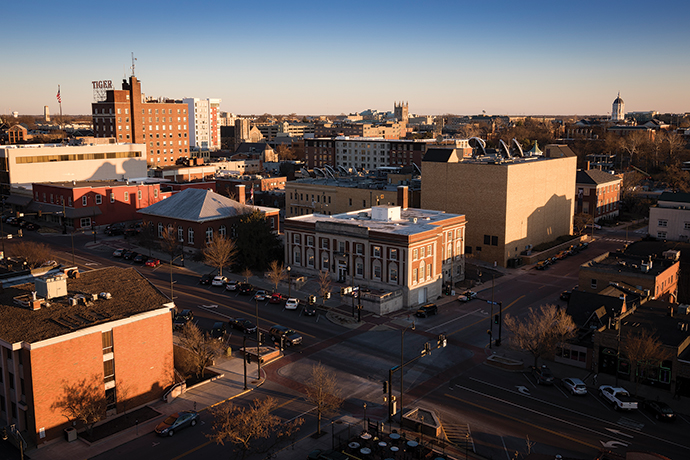Double-digit unemployment — that’s where my career in economic development began.
As the country struggled to pull itself out of the Great Recession, I spent my days in workforce and economic development activities ranging from assisting displaced workers to providing resources to businesses to aiding communities in creating a better tomorrow.
I was fortunate to cut my economic development teeth in East Central Indiana, between the state’s largest and third largest cities (Indianapolis and Fort Wayne). The area’s largest city is Muncie (pop. 68,000), home to Ball State University, and the smallest is Jonesboro (pop. 1,600).
The area’s history is rooted in the industrial revolution: agriculture, automotive, glass and natural gas all shaped its economy. The region is filled with lush fields and beautiful landscapes. Peaceful drives down these country roads inspire Hollywood and Nashville alike.
The people are generous to the core, and a request for help never goes unanswered — “salt of the earth” plays on repeat in my mind. In true Hoosier fashion, the area contains three of the largest high school basketball gymnasiums in the world. The name of one of these schools included “Chrysler” for more than 50 years — a tribute to the automaker which, at its height, employed 6,700 local workers.
But despite the beauty of its people and scenic landscapes, there were times the hill we were climbing — to advance the community toward a more prosperous future — seemed more like Mt. Everest.
Was the deck stacked against us?
This is the question hundreds of midsized regions across the U.S. are asking, located throughout “flyover country.” Collectively, these regions could be referred to as “Nowhere, America.” Leaders in these locales are justified in feeling the challenges are sometimes insurmountable. During the past 50 years, the global economy has evolved in many incredible and positive ways. But many of those transformations have left Nowhere, America, behind.
The economy demands people. Migration patterns show metropolitan areas have been magnets. As more people chose an urban/suburban lifestyle, retail followed. In addition to retail access, walkability, entertainment options, restaurants, art scenes and other amenities became differentiators between metro areas and Nowhere, America.
While other issues are not exclusive to Nowhere, America — delayed broadband infrastructure, the opioid epidemic, shrinking tax bases, poverty — they have certainly contributed to the widening gap between winning and losing communities in the modern economy.
‘You Are My Density’
I always thought it would take seismic change to alter the disadvantaged position of Nowhere, America.
Enter 2020.
The COVID-19 pandemic will surely change life in drastic ways. Simultaneously, an inspired national movement is driving what could potentially be the most impactful progress we’ve seen on racial equity since the civil rights movement of the 1960s. Could these two historic events create a new normal which cedes some advantages to Nowhere, America?
Metro areas and Nowhere, America, are separated primarily by one characteristic: population density. Nowhere, America, has one thing that urban America cannot replicate: space. Roads, grocery stores, classrooms, neighborhoods, parks, restaurants, hospitals, sidewalks, places of worship, theaters — all of these are simply less congested.
The disruptive events of 2020 will cause some companies and individuals to consider the advantages of life in areas with less density. Some parents may be drawn to schools that offer smaller class sizes and well-designed STEM programs. Employees may be attracted to shorter commutes, which enhance work-life balance and are typically more favorable to a household’s bottom line. The idea of an affordable single-family home is attractive. Indeed, firms and workers would save a few bucks as costs in Nowhere, America, are consistently lower than in metros.
Will there be a mass exodus from metro areas? Of course not. Assuming public health and safety remain stable in the long term, urban cores across the country will continue to be centers of gravity and combine with adjacent suburbs to maintain potent metro areas. Urban areas tend to drive business, finance, innovation, culture and politics. Because of these economic drivers, the streets and public squares that weave through urban power centers become natural locations to advocate for change. These important moments in the evolution of our country often produce intended outcomes that improve our society, but they usually create unintended outcomes as well. Protests, curfews and boarded-up storefronts, even for a cause one supports, create uneasiness and strife for local residents and businesses.
The civil unrest that occurred during the 1960s did not on its own create a relocation trend, but it did impact domestic migration patterns by accelerating changes that were already underway. Likewise, the events of 2020 could have a measurable effect on where Americans choose to live and work going forward.
Acting on Best Intentions
Given these factors, Nowhere, America, will likely see an increase in opportunities to attract residents and businesses. If nothing else, COVID-19 has given us plenty of time to reflect on life, as we consciously think about our health and safety on a daily basis. We reflect on how and where we spend our time. We think more about the air we breathe, our neighbors and local businesses. Some people may be more intentional about which lifestyle they want and ultimately choose to relocate to achieve it.
For decades, our economy has pushed many people to live in metros — that’s where the jobs were and largely still are. While still imperfect, companies and workers have found, in many cases, remote work is a viable option for productivity and collaboration.
A critical mass of workers will likely choose to live in less dense areas, driven by lifestyle and the benefits they expect to realize in individual and public health. This mass will generate sufficient pressure on the labor market to accept remote work broadly and to narrow the wage gap between urban and rural workers in certain disciplines. A virtual approach to education will provide further geographic freedom. These changes and other developments may lead to some decentralization of the economy, which has the potential to yield positive outcomes in how Americans work and live.
This is a hopeful message for all of Nowhere, America. But local leaders must remember the U.S. economy has historically rewarded communities that invest in themselves. Nowhere, America, has been required to make public investments to provide modern amenities like broadband, walkability, housing, arts, entertainment and others, which often require public dollars or public-private partnerships. Communities that have made these investments over the last 20 years are likely to be the first to benefit. Those with antiquated attitudes, policies and leadership — and those unwelcoming of diversity — will continue to struggle. There is no better time than now for rural and less populated communities to turn toward the future. Local public and private leadership — as it always has — will determine whether opportunities are seized or squandered.
Everyone should embrace this optimism, not just Nowhere, America. Economic development is not a zero-sum game, nor is it about political parties or ideology. It is about access to the economy, which means access to reliable income, quality education and opportunity for future generations. All should celebrate meaningful shifts which provide greater access to the modern economy for more communities and welcome more populations into economic prosperity.
I grew up in Nowhere, America. I worked in Nowhere, America. I believe in Nowhere, America. A stronger Nowhere, America, will make us a more complete and equitable country. A rising tide lifts all boats, but so does a ripple.

Jacob Everett, CEcD, former executive director of the Indy Partnership, is a consultant for McGuire Sponsel, a national advisory firm assisting CPA firms and businesses on specialty tax solutions and economic development credits and incentives.
